This is a Focasport II C, a 35mm rangefinder camera made by Optique & Précision de Levallois, in Levallois-Perret, France starting in 1963. The Focasport II C is part of a long line of Foca and Focasport models, featuring a coupled coincident image rangefinder, coupled selenium exposure meter, a between the lens leaf shutter with top 1/500 speed, and a good 3 element Foca Neoplar f/2.8 lens all in a unique brick shaped body. Despite having attractive looks and a competitive feature set, the Focasport II C was not on sale for long, as most Foca models from this era had sluggish sales, leading to a cheapening of the series, eventually becoming low end plastic point and shoots.
Film Type: 135 (35mm)
Lens: 4.5cm f/2.8 Foca Neoplar coated 3-elements in 3-groups
Focus: 1 meter to Infinity, Front Cell Focus
Viewfinder: Combined Coincident Image Coupled Rangefinder w/ Aperture Scale
Shutter: Between the Lens Leaf
Speeds: B, 1 – 1/500 seconds
Exposure Meter: Coupled Selenium Cell w/ top plate and viewfinder match needle
Battery: None
Flash Mount: Cold shoe and M and X Flash Sync
Weight: 630 grams
Manual (in French): https://mikeeckman.com/media/FocasportIICManual.pdf
How these ratings work |
The Focasport II C is one of the last cameras produced by Optique & Précision de Levallois before they exited the camera making business, and although built with a lot of plastic and featuring a simple triplet lens, the Focasport II C has an excellent coupled rangefinder, match needle exposure system, and an excellent viewfinder that makes images that look a lot better than the camera’s specs suggest. This is an uncommon camera in France, and is all but impossible to find in the United States, but if you ever do find one, they’re worth checking out. | ||||||
| Images | Handling | Features | Viewfinder | Feel & Beauty | History | Age | |
| 2 | 1 | 1 | 2 | 1 | 1 | 20% | |
| Bonus | +1 for the complete package, this camera is more than the sum of its parts | ||||||
| Final Score | 10.6 | ||||||
History
 OPL, or Optique & Précision de Levallois was at one time one of the world’s oldest optics companies, predating many more well established German and Japanese companies.
OPL, or Optique & Précision de Levallois was at one time one of the world’s oldest optics companies, predating many more well established German and Japanese companies.
OPL was founded in 1919 by Armand de Gramont the Duke of Guiche, then 12th Duke of Gramont. Armand de Gramont was a French industrialist and scientist, born on September 29, 1879 who in his earlier years was fond of painting. In 1904, Gramont showed off his talents and had an art exhibition at the Salon des Artistes Français. Despite his talents, Gramont’s family pushed him towards a more serious career in the sciences.
Around 1910, Gramont established the Institute of Theoretical and Applied Optics and the Superior School of Optics, two organizations he would remain connected to for the rest of his life.
During the first world war, Gramont observed that the French military was lacking in both precision optics equipment and engineers to develop anything new, so in 1916, he and the Institute of Theoretical and Applied Optics established principles that were taught for the creation of military optical equipment. At this time, Gramont’s contributions were only of the educational kind, and he was not involved in the design or creation of any new equipment, only how to do it.
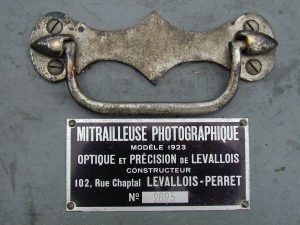
In 1919, Gramont would form a dedicated company called Optique & Précision de Levallois for the purpose of creating optical devices such as rangefinders, scopes, and other optical devices exclusively for the French military. This would remain how things were until 1938, at which time, Gramont wanted to expand to civilian production and start selling cameras and other devices to customers other than the French military.
To accommodate new product lines, a new factory was built in Châteaudun exclusively for civilian consumption. Although several sources online suggest this new factory was created in 1938, I could not find any evidence of cameras or other consumer products until after the war. It is plausible that just as the factory was about to get started, it shifted over to war production, much like optics factories all over the world did.

An early prototype, thought to have been built in either 1942 or 1943 appeared in the March 1954 issue of FOCAgraphie Magazine featured a body that closely resembled the Foca PF1 from a couple years later, with a screw lens mount, and a limited selection of shutter speeds. Strangely, within the film compartment was a mask that would have produced tiny exposures, possibly around 12mm x 18mm, suggesting, this might have been a special purpose camera, not for general photography.
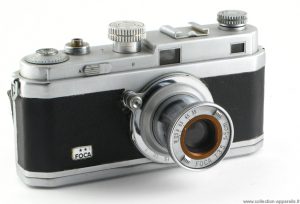
Beyond this one prototype, little is known what OPL worked one between 1938 and 1945 when the rangefinder equipped Foca PF2 was released. A year after its release, the non-rangefinder equipped PF1 went on sale, with both cameras closely resembling the 1942 prototype.
Over the course of the next two decades, a huge number of Foca branded cameras were released, many with similar features and confusing names that make differentiating between different models very difficult.
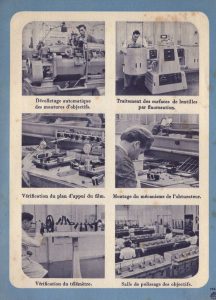
In 1955, a new line up of simpler and less expensive Focasport cameras was created. The first model, simply called the Focasport, was a simple scale focus camera with an Atos leaf shutter with a top speed of 1/300. It came with a Foca Neoplar 4.5cm f/3.5 triplet with front focusing.
Many Foca cameras were simple scale focus or rangefinder equipped models, most early models had focal plane shutters. but later models offered leaf shutters, some offered a screw lens mount, and some even offered a proprietary bayonet lens mount. The more advanced Foca models, such as the Universel R, were sometimes though to be “French Leicas” although in reality, the only place the two cameras might have competed head to head would have been within France.
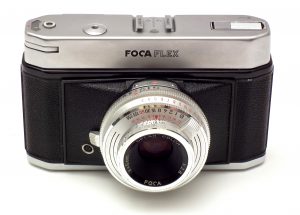
In 1960, OPL even produced a leaf shutter Foca SLR called the Focaflex which had a uniquely designed flat top hiding a series of mirrors that took the place of a pentaprism normally found in an SLR. Sylvain Halgand has a list of most Foca branded names on his website which shows how complex the company’s offerings were.
By the 1960s, with the landscape of the photographic industry changing, along with the rise of cheaper and more advanced Japanese cameras, OPL’s Foca brand favored more budget models. The Focasport series expanded with several models, and in 1961, an all new camera called the Focamatic made its debut with a unique brick like body, mostly black and chrome design, and a selenium exposure meter with full programmed automatic exposure. Although not technically part of the Focasport series, the Focamatic would debut a new design that would be used in all later Focasport models.
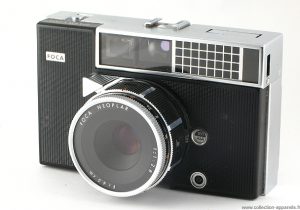
Between 1962 and 1964, five new Focasport models featuring a similar body and design to the Focamatic, but without auto exposure, would make their debut. The top of the line model, the Focasport II F, had a coupled rangefinder, a four element Foca Neoplex 4.5cm f/2.8 lens, but no exposure meter. The simplest, called the Focasport I also had no meter, but was scale focus only and had a simpler triplet lens.
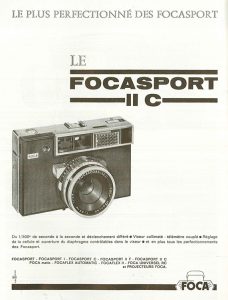
The final model in the second generation Focasport series, was the Focasport II C was the only model with both an exposure meter and rangefinder together. In order to fit both into the narrow body, OPL shortened the base length of the rangefinder so that it could fit. The selenium exposure meter controlled a match needle visible in the viewfinder, but without any automatic exposure capability. The lens was also the a simpler Neoplar triplet.
As was the case of most Foca cameras, they were produced primarily for sale in France and while I am sure some likely were exported to nearby countries, I have never seen any indication of any sort of official US distributor, making all Foca cameras very hard to find here.
I also could not find any reference for how much these sold for, so coming up with an estimated value in current US dollars would be entirely guesswork.
The Focsport II C was not likely produced for long as it was the last in the second generation before OPL released a new generation of even cheaper Focasport models in 1965. There exist two variations of this camera, one with black trim around the rangefinder window, and one with white trim like the one being reviewed here.
According to Gérard Langlois’s Foca camera website, the last model, a plastic Instamatic camera called the Foca Marly was made in 1967, but I don’t see anything after that. Shortly before the last models were produced, in 1964, Optique & Précision de Levallois merged with Société d’Optique et de Mécanique de Haute Précision, makers of SOM-Berthiot lenses. It seems that as camera production wound down, the combined company focused its efforts elsewhere, ending the era of the Foca camera.
Today, there are collectors of nearly every type of camera. I am certain there are French camera collectors, but for the general collector who just likes things that are different, Foca cameras represent a big opportunity for something that’s different enough from the German, Japanese, and Soviet cameras that were common from the same era, but are still worthwhile models to pick up.
I don’t know that many people would likely seek out the Focasport II C, but that has nothing to do with any shortcomings of the camera, rather it is because most people know so little about them. This is a well equipped compact rangefinder with a good lens and decent build quality, and if found in good condition would make for a fun camera to shoot. You could certainly do a lot worse!
My Thoughts
Who has one good eye, two thumbs, and an inexplainable fondness for brick shaped cameras? This guy!
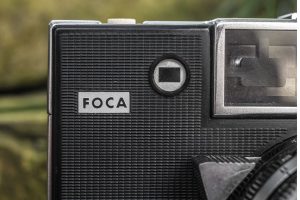
Whether it is a Contax I, Argus C3, or Voigtländer Vitessa 1000SR, if a camera was made in the 20th century that had six distinct faces and eight 90 degree corners, chances are, I’m gonna want one.
On the rarity scale with a broken Zenit on one end and a half frame Nikon S3 rangefinder on the other, the Focasport II C is probably somewhere in the middle, but when I had the chance to borrow one from fellow collector Garrison Way, I jumped at the opportunity. Garrison warned me that he had only recently picked up the camera and never had a chance to shoot it. He believed it to be in good working condition, but wasn’t totally sure, but I took him up on the opportunity anyway.
When the camera arrived, I was pleased that it appeared to be in excellent working condition. The exposure needle in the viewfinder did respond to light, but it didn’t appear to be anywhere close to accurate, but the rangefinder looked correct at infinity, and the shutter sounded accurate at all speeds. That’s good enough for me, I thought, and I quickly loaded up the camera and went shooting.

The top plate has a clean design with a few features that at first glance, aren’t obvious what they do. Starting on the left is the folding rewind knob. Unlike most 35mm cameras where you can see the entire round rewind knob, the Focasport II C has a clever rewind handle that folds and retracts into the body when not in use. All you see is the side of the handle, allowing the top of the camera to remain flat on this site.
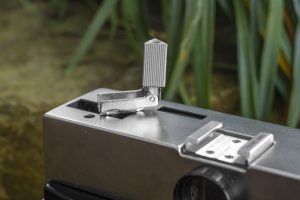
When it is time to rewind the film at the end of a roll, using your fingernail, lift up on the handle and pull up until it reaches its limit, then fold the handle at a right angle until the plastic tipped handle is facing upward, as in the image to the left.
Immediately below the rectangular opening for the rewind handle is a small hole that has a film transport indicator that spins when film is being advanced through the camera or when it is rewinding.
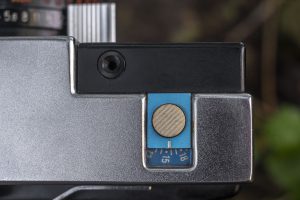
On the right side of the top plate is a threaded cable release socket for long exposures, and the exposure counter. The exposure counter is in a blue window, and counts backwards, showing how many exposures are left. When loading in a new roll of film, the counter must be manually reset to however many exposures the roll of film has, by pressing and rotating the white button above it.
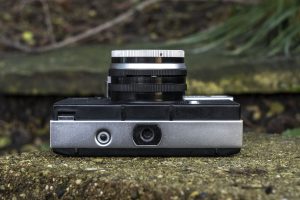
Flip the camera over and the bottom features a centrally located 1/4″ tripod socket, the rewind release button, and in the corner, the release latch for the film door. With the camera upside down, press in on the chrome latch and the film door will open. This location for the door latch is not obvious and likely caused many first time users of this camera to struggle when it comes time to load film into it.
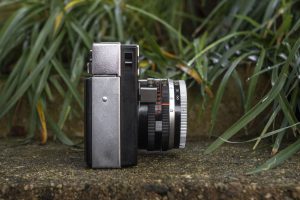
The sides of the camera are as flat and brick-like as the others. Recessed strap lugs are on both sides that when not in use, do not protrude out of the camera, maintaining its sleek appearance. From this side of the camera, you can see the length of the lens and shutter, and also the front plate shutter release.
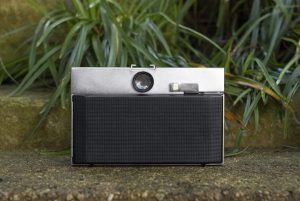
Around back, a large round opening allows you to see through the viewfinder. Its large size meant I could easily see the entire image while wearing prescription glasses.
To the right of the viewfinder is the film advance lever, which wraps around the side of the camera in a single stroke.
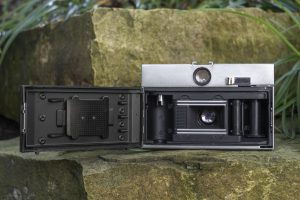
Open the film compartment using the release latch on the bottom, and the left hinged door swings open. Film transport is from left to right, onto a fixed and double slotted take up spool.
On the inside of the door is a black painted pressure plate with divots in it to reduce friction as film passed across it. Above and below the pressure plate are round protrusions that rest in equally shaped indentations in the camera body, preventing the pressure plate from wiggling around when transporting film.
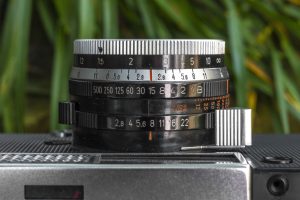
Looking down on the lens, the Focasport II C works like most other leaf shutter cameras. Closest to the body is the aperture selector which can easily be turned using a black tab that sticks out to the side of the ring. There are no click stops for each indicated f/stop.
In the middle is the shutter speed selector with speeds from 1 to 1/500 plus Bulb. Thankfully, the Focasport II C does not feature any kind of EV or LVS system that couples the shutter speed and aperture rings together, making it very easy to use.
Between the shutter speed and aperture rings is an ASA film speed dial showing speeds from ASA 12 to 1600 for the exposure meter. Normally this ring is locked, but when you want to change it, you must press in a gray plastic rectangular button on the side of the lens, which you can see in the next picture.
Finally, farthest away from the body is the focus ring which is indicated in meters from 1 meter to infinity.
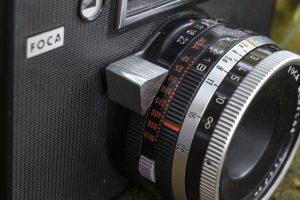
On the front face of the camera, near the 10 o’clock position around the lens is the triangular shutter release. This location is in a comfortable location for your right index finger. A threaded socket for a cable release is located on the top plate of the camera.
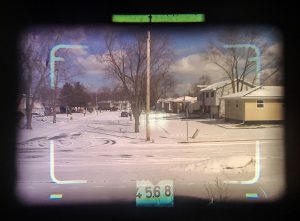
The viewfinder is large and bright and is one of the best parts of the Focasport II C. Where most earlier models in the series were quite basic, some with a meter and some with an exposure meter, the II C is the only one with both.
The main part of the viewfinder has a pink tint to it with the rangefinder patch, projected frame lines, and aperture scale in blue. Above the viewfinder visible only with your eye in a very specific location is a horizontal green exposure scale. The scale has no marks to indicate over and over exposure, but from looking at the manual, as long as the needle is visible at some point in the scale, proper exposure can be made.
I had no problem composing or focusing this camera in any kind of light, both indoors and outdoors. I also could easily see the edges of the projected frame lines while wearing prescription glasses, making this camera a joy to use.
The Focasport II C is certainly an uncommon camera, especially in the United States. Based on my limited experience with other cameras in the Focasport series, most of them are decent, but unremarkable cameras. The Focasport II C however, is a step up from those more basic models. It has everything you need to make great photos, including a nice triplet lens, good ergonomics, and an excellent viewfinder. Before I ever handled a Focasport II C, I was intrigued by its good looks, but after handling it, my enthusiasm grew as this camera’s strengths were greater than skin deep.
My Results
The owner of the Focasport II C told me that he had never shot this camera before, and there’s no telling how long since it was shot by some previous owner, in what was likely the camera’s first roll of film in quite some time, I chose some bulk Kodak TMax 100. This is a safe film that has a wide range of latitude so it can accommodate variances in shutter speed and delivers predictably good shots, all great characteristics to have in a film being used in a camera of unknown operation.
I had a bit of fun shooting the Focasport and that resulted in me going through the roll in a single day. I find that when I’m out shooting a new camera, the speed at which I finish the roll directly correlates with how much I enjoy using the camera. With the hope that my enjoyment of the Focasport II C would turn into a whole roll of good images, I was excited to get the film into the tank and see what I got
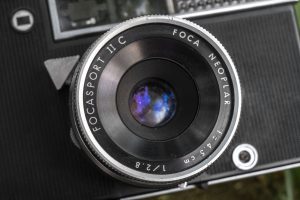
As the first images from that roll showed up on my scanner, I was amazed at not only the sharpness of the images, but the overall look. The results from the Foca Neoplar lens reminded me quite a bit of the LOMO T-43 triplet on the Smena 8 camera I reviewed a while back.
Loaded with a ton of character and very good sharpness for a three element lens, the images from the Neoplar show just enough softness and vignetting in the corners to give the cameras a distinct look, without being distracting or mushy like a lesser lens might.
Although a majority of the images were shot on an overcast day or indoors, the few with a bright sky like the mailbox image or the reflection of the sun on the top of the school bus show a bit of blooming. Looking through the lens, I saw no haze, so this must be characteristic of the lens, further adding to its “glow”.
Finally, the indoor images had a lot of character too. In the mirror selfie and one of the hairless cat, there’s a huge amount of contrast, more than I am used to seeing on Kodak TMax suggesting that in a future roll through this camera, I should try more indoor shots as I really like how those came out.
The Focasport II C was generally a pleasure to shoot. Its brick like shape and sharp corners didn’t negatively impact the user experience. Compared to the most famous brick camera, the Argus C3, the Foca is a bit thinner and lighter, making it easier to handle. The film advance worked fine, focus, shutter speeds, and aperture controls all worked exactly as they should. The viewfinder was bright and easy to use, and although I did not use the meter on this example, my ability to read the location of the needle was easy enough.
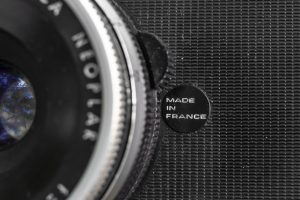
The one aspect of the camera’s design was the shutter release on the side of the shutter. Its location wasn’t an issue, but the feel of its action was. It is clear to me that some cost cutting went into the design of the shutter release, and while the one on this camera worked fine, there was a bit of play in it which didn’t instill confidence in the camera’s long term operation. I would suspect that this example was hardly used throughout its life, but had it seen many years of regular use, it likely wouldn’t hold up well.
At the time of the Focasport II C’s release, Foca was already looking down market in their cameras, and it shows. That doesn’t necessarily make this a bad camera, as clearly, I got some great images from it, and for someone in France looking for a well featured budget camera, this would have been a great option, but there is a reason these cameras are hard to find today, especially outside of France. By 1963, the Japanese camera industry was already in full swing, churning out a huge number of similarly good cameras for prices that were probably just as, if not more affordable for the rest of the world. I don’t think these were exported out of France, but if they were, I would suspect they were a tough sell, which is why you hardly see them today.
For the collector’s market though, the Focasport II C is a great addition to any collection because of how uncommon they are today. For anyone wanting to shoot one, as you can see from the gallery above, they are capable shooters, but even if you just want one to sit on a shelf, they have an uncommon design that stands out from all those very similar Japanese models.
Related Posts You Might Enjoy
External Links
http://camera-wiki.org/wiki/Focasport
http://roland.weber4.free.fr/_app/_app_obtu/app_obt.htm (in French)
http://glangl1.free.fr/Somm-Foca.html (in French)
http://www.foca-collection.fr/focasport.html (in French)

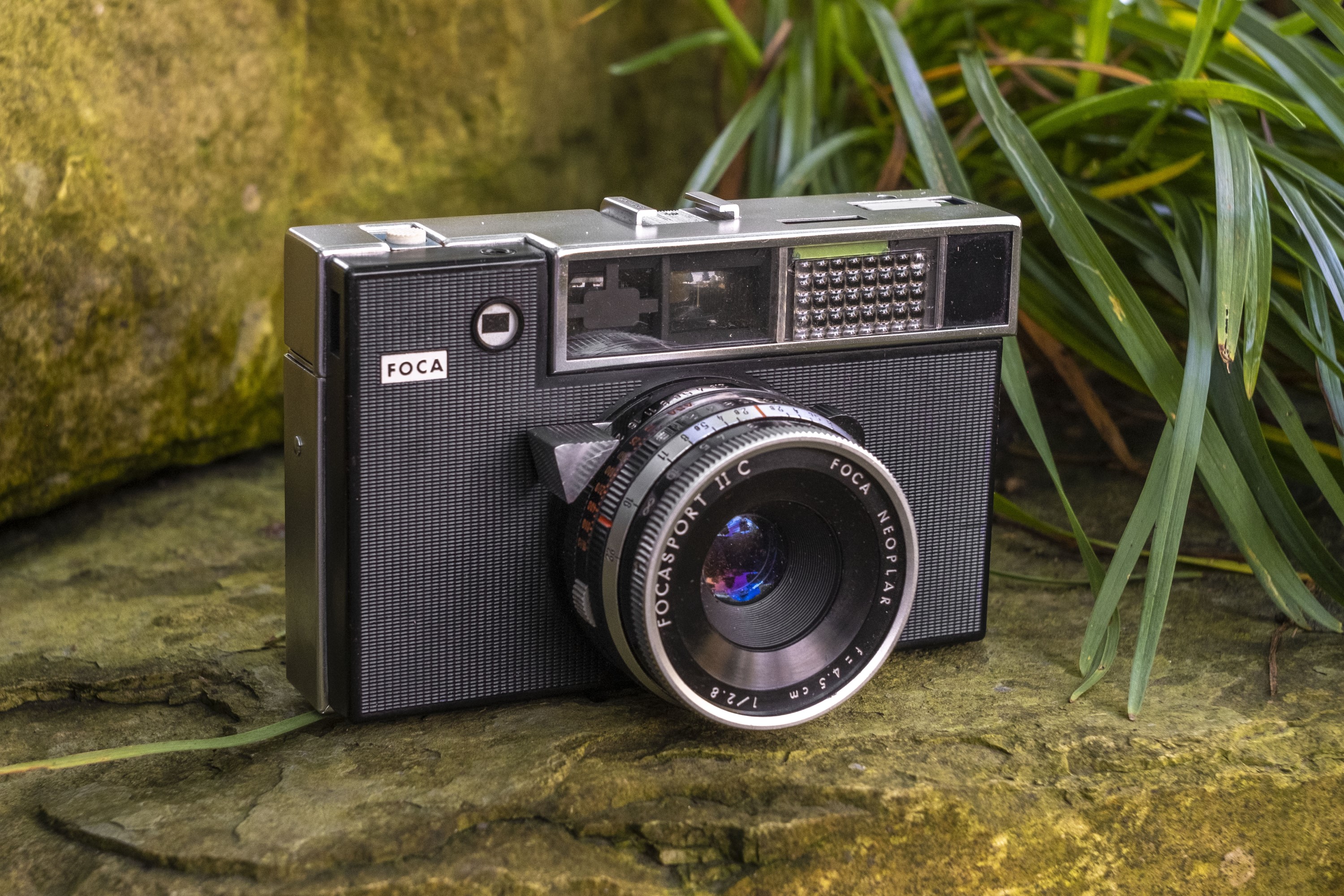
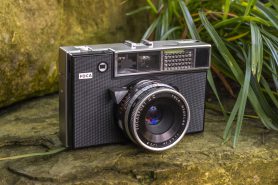
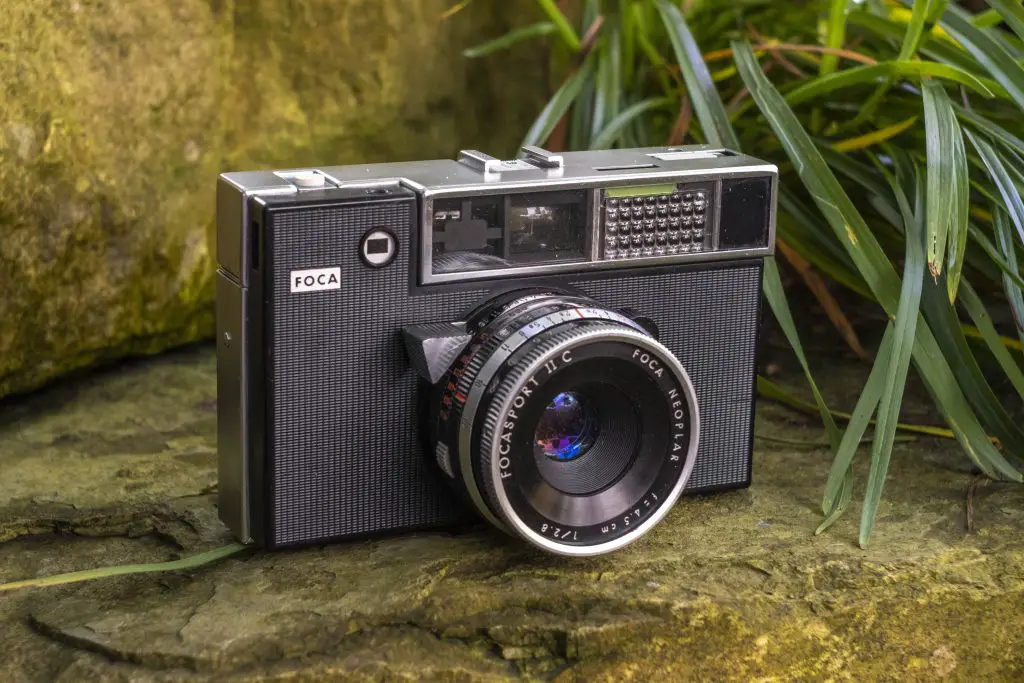

















What a fine review, Mike. Learned a lot about an obscure (in America) manufacturer as well as about a camera with a terrific triplet lens – joining ranks with the Meyer Trioplan. These lenses are noted for fine bokeh wide open, and can produce fine portraits – especially the 105mm and 135mm triplets from Japan circa the 1960s.
Nice! I had never seen a Focasport in such detail, they’re cameras almost forgotten by now (as opposed to the PF and Universel series, which have a cult following).